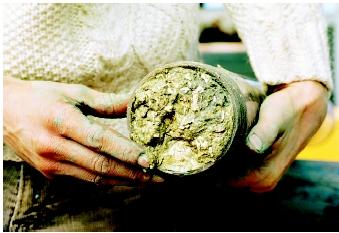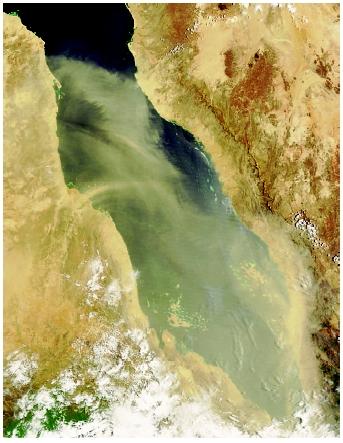Ocean-Floor Sediments
Sediment on the seafloor originates from a variety of sources, including biota from the overlying ocean water, eroded material from land transported to the ocean by rivers or wind, ash from volcanoes, and chemical precipitates derived directly from sea water. A very small amount of it even originates as interstellar dust. In short, the particles found in sediment on the seafloor vary considerably in composition and record a complex interplay of processes that have acted to form, transport, and preserve them.
Geological oceanographers have coined the terms "terrigenous" to describe those sediments derived from eroded material on land, "biogenic" for those derived from biological matter, "volcanogenic" for those that include significant amounts of ash, "hydrogenous" for those that precipitate directly from sea water, and "cosmogenic" for those that come from interstellar space.
The seafloor, however, is not a random arrangement of these different sediment types. Oceanographers have painstakingly mapped the distribution of sediment around the globe and have learned that at any given location the sediments provide important information regarding the history of the ocean as well as the overall state of climate on the Earth's surface. By studying how the heterogeneous composition of sediment varies as a function of geographic location and age, oceanographers are able to document the geologic and climatic conditions that are responsible for that sediment.
Oceanographers study sediment by taking long cylindrical cores, which individually can be as long as 18 to 30 meters (60 to 98 feet). Because the bottom of the ocean is extremely cold (only 1 to 3 degrees above freezing), the cores are stored in refrigerators onboard the research ship prior to being stored in large refrigerated repositories at shore-based laboratories. In their laboratories, scientists study the physical, chemical, and biological makeup of the sediment.
Regardless of which type of sediment, there are three processes that are responsible for its final composition: namely, the production of the sediment;

The different combinations of each process' effectiveness result in a commensurate variety of sedimentation rates. Sediment can accumulate as slowly as 0.1 millimeter (0.04 inch) per 1,000 years (in the middle of the ocean where only wind-blown material is deposited) to as fast as 1 meter (3.25 feet) per year along continental margins . More typical deep-sea rates are on the order of several centimeters per 1,000 years.
Production of Sediment
The production of marine sediment is more complex than it may seem. Terrigenous sediment is produced by an interplay of chemical and physical weathering processes, which collectively serve to create small grains of material ranging in size from thousandths of millimeters to 1 or 2 millimeters(0.04 or 0.08 inch). (The larger grains of coarse sand, gravel, and boulders are too large to be transported to the deep sea and therefore are not discussed here.)
Physical weathering is caused by mechanical fracturing of rocks, such as that due to the freezing of water in cracks, and results in finer grained, compositionally similar examples of the original rock. On the other hand, chemical weathering, caused by the weak acid produced by the interaction of rainwater and atmospheric carbon dioxide, degrades the rock slowly and often produces fine-grained minerals that are compositionally distinct from the original rock.
Biogenic (biologically derived) sediment is produced by marine plankton, which are small, often microscopic, unicellular plants and animals that float in the surface waters of the ocean. The shells of these organisms are made of either calcium carbonate (CaCO 3 ) or silica (SiO 2 ). Although ubiquitous, particularly elevated concentrations of such organisms are most commonly found in biologically productive waters such as the Equatorial Pacific, or the Southern Ocean ringing the continent of Antarctica.
Volcanic ash is produced during volcanic eruptions, as can be seen in the billowing ejected material from many volcanos. Cosmogenic material is the remains of primordial material left over from the creation of the solar system (and perhaps from beyond) and, although very low in abundance, is ubiquitously distributed.
The production of hydrogenous sediment is most difficult to visualize, but involves either the slow precipitation of dissolved chemicals from sea water or the leaching of chemical elements from rocks that have extremely hot sea water (greater than 300°C [572°F]) circulating through them along mid-ocean ridges. When these hot solutions are injected into the cold sea water the leached chemical elements precipitate from the cooling water, leading to hydrothermal sediments near the mid-ocean ridge that are enriched in iron, manganese, copper, zinc, and other metals.
Transport of Sediment
The transport of sediment depends on its grain size and the original location where it was produced. Terrigenous sediment can be transported to the deep sea via rivers or by wind. Material transported by rivers most commonly ends up deposited on the continental margin, the shallow portions of the ocean that are within several hundred kilometers of land. When continental margin deposits accumulate fast and get overly steep, or when an earthquake or storm causes the sediment to be resuspended, turbidity currents provide additional transport out to the deep sea. The resuspension of the sediment into the bottom water causes it to be more dense than the overlying water, and thus these turbidity currents flow downslope to the more distant ocean basin.
The transport of sediment by wind is also extremely significant, and is particularly relevant to studies of Earth's climate in the past. When the Earth's climate is relatively dry (arid), such as during glacial periods, the land surface tends to be more dusty, and thus during such periods there will be more windblown terrigenous material delivered to the deep ocean. Also, during such time periods the wind speed tends to be higher, and thus terrigenous grains that are slightly larger than usual are preferentially transported. Thus, by examining the amount of dust, as well as its grain size, in the different layers of a sediment core, oceanographers learn how arid the land surface was at a given time, as well as how fast the average wind speeds were.
Although such dust is essentially invisible to the human eye, its transport is still an important and long-ranging process. For example, dust derived from the Sahara in North Africa is easily observed in Miami, Florida and even in the eastern Pacific Ocean. Moreover, volcanic ash ejected tens of kilometers into the atmosphere during the largest eruptions can be transported by winds all around the globe.
The microscopic shells of the plankton do not just simply fall to the seafloor. In fact, because they are so small, the plankton may not be able to

By examining the material trapped by these instruments, it was discovered that plankton shells are delivered to seafloor by "biopackaging" via fecal pellets. In other words, various microorganisms that eat other plankton excrete their shells in fecal pellets. These "biopackaged" fecal pellets are large enough (0.2-1.5 millimeters, or 0.008-0.059 inch) and dense enough to sink to the seafloor, where they become part of the sediment.
Hydrothermal sediment is largely localized to within less than 10 kilometers (6.2 miles) of the mid-ocean ridge. The concentration of metals in these sediments decreases with distance from a ridge, yet small amounts can be found up to 500 to 1000 kilometers (300-600 miles) away.
Preservation of Sediment
Terrigenous sediment, whether it be delivered by rivers or wind, is not altered significantly on the seafloor and thus is well-preserved. During very deep burial (e.g., 5 kilometers, or 3 miles, below the seafloor), the terrigenous grains can be altered into different minerals, but this does not occur while the grains are lying on the seafloor and is generally a more important process for geologists rather than oceanographers.
Biogenic sediment, on the other hand, is very poorly preserved on the seafloor. The degradation of biogenic sediments is a complex, largely chemical suite of processes. The preservation of these sediments is a field of study that has captivated oceanographers for over 100 years, dating from when they were discovered in the mid-1800s during the first oceanographic research cruise by the ship HMS Challenger.
For example, significantly less than 1 percent of the siliceous plankton that are biopackaged to the seafloor are preserved. This is because sea water is undersaturated with respect to silica. Therefore, the siliceous plankton are living in an environment that is corrosive to their shells.
While the plankon is alive, the shell is surrounded by organic protoplasm that protects it from the corrosive sea water. After death, however, even if biopackaged, this organic coating will degrade, exposing the shell of the siliceous plankton. When exposed to sea water, the shell will dissolve.
This process occurs over all depth and temperature ranges throughout the global ocean. Thus, the only regions of the seafloor where biogenic silica appreciably accumulates is where the production of biogenic silica is so enormous that it overwhelms the amount that is dissolved. In the modern oceans, this occurs at high latitudes in the North Pacific and Southern Ocean and the Equatorial Pacific Ocean.
Plankton with shells made of calcium carbonate also commonly dissolve, but not as commonly as siliceous plankton. The dissolution of carbonate plankton is controlled by water depth and water temperature. Water depth and hydrostatic pressure correlate with each other—at greater depths there is greater pressure. At greater pressures, the solubility of carbon dioxide gas increases. An excellent analogy of this process is observed in a bottled carbonated beverage that is under pressure until opened—when the pressure is released the carbon dioxide comes out of solution and bubbles form. Similarly, at the great depths of the deepest seafloor, the solubility of carbon dioxide increases so much that calcium carbonate sediment may dissolve. This dissolution is also facilitated at the lower temperatures of the deep sea.
The converse is also true. At shallow water depths (that is, lower pressure) the carbonate does not dissolve and the warmer water temperatures (along with the increased light for photosynthesis ) each serve to enhance the construction and preservation of coral reefs and other carbonate-producing biota. Thus, there is both a depth and latitudinal effect on the distribution of carbonate sediments due to their influence on temperature and pressure.
SEE ALSO Algal Blooms in the Ocean ; Mineral Resources from the Ocean ; Ocean Biogeochemistry ; Ocean Currents ; Oceans, Polar ; Plate Tectonics ; Plankton ; Radionuclides in the Ocean .
Richard W. Murray
Bibliography
Charnock, H., J. M. Edmond, I. N. McCave, A. L. Rice, and T. R. S. Wilson. The Deep Sea Bed: Its Physics, Chemistry, and Biology. London, U.K.: The Royal Society, 1990.
Cronan, D. S., Underwater Minerals. London, U.K.: Academic Press, 1980.
Ernst, W. G., and J. G. Morin, eds. The Environment of the Deep Sea. Upper Saddle River, NJ: Prentice-Hall, 1982.
Lisitzin, A. P. Oceanic Sedimentation, Lithology, and Geochemistry. Washington, D.C.: American Geophysical Union, 1996.
Morse, J. W., and F. T. Mackenzie. Geochemistry of Sedimentary Carbonates. Amsterdam, Netherlands: Elsevier, 1990.
MANGANESE NODULES
Manganese nodules are concretions enriched in manganese, iron, cobalt, copper, zinc, and other metals that are found laying on seafloor in regimes of extremely low sedimentation rate. Manganese nodules nucleate or begin to grow on a previously existing particle (commonly a small fish bone or shark's tooth) and derive their chemicals from the extremely slow precipitation of the metals directly from sea water. Because their accumulation rates are on the order of 10 millimeters (0.04 inch) per 1 million years, oceanographers interested in past ocean history can study the composition of their individual layers and derive a record of ocean change that can be as long as 50 million years in a single nodule of a 5-centimeter (2-inch) radius.